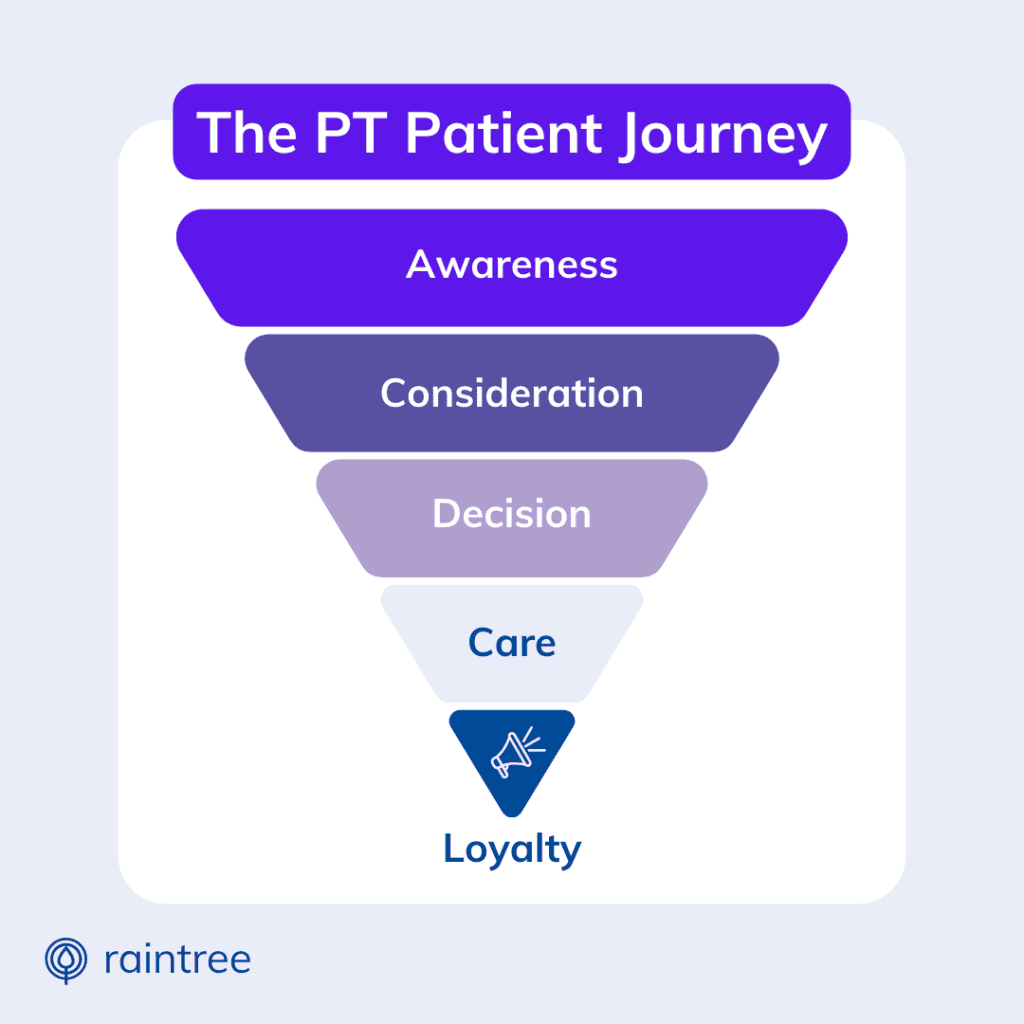The PT patient experience isn’t just the path from first appointment to discharge.
It includes all the questions, expectations, achievements, and adjustments along the way… Laying the foundation for a long-term relationship that will evolve along with your patient’s lifetime needs.
To map the path to a better patient journey, let’s take a lesson from physical therapy expert and owner of Strong & Healthy Rehab, Matt Huey.
Walking With Your Patients on Their Physical Therapy Journey
Let’s introduce Matt Huey, PT, Dip MDT, FAAOMPT!
Huey is one of only 30 physical therapists in the United States to have both a diploma in Mechanical Diagnosis and Therapy and a Fellow of the American Academy of Orthopaedic Manual Physical Therapists (FAAOMPT) designation. He’s also a practitioner and diplomat in the McKenzie Method of PT assessment and management of spinal and MSK disorders.
Huey joined a recent episode of the Therapy Matters podcast to talk about his patient journey philosophy—and how PTs can “walk with” patients from point A to point B and beyond.
1. Establishing the Therapist-as-Guide
Within the patient journey toward recovery, Huey views the physical therapist’s role as being a guide and go-to resource.
The Patient Journey Begins with a Question
“If somebody came up to me and is like, ‘I need to get my hair done, where am I going to go?’ I’ll say, ‘Oh, go to my hairdresser.’ Or, ‘I need to get my teeth cleaned. My tooth hurts.’ ‘Go to my dentist.’ I tell people, ‘I want to be your therapist.'”
To your community, your clinic should be the source of guidance when it comes to chronic pain, mobility, injuries and injury prevention, certain chronic illnesses, physical rehabilitation, and more (depending on your area of focus).
With this philosophy, you’re not thinking of patients as just an ideal number of appointments or billing codes to be processed—you’re thinking about how your services fit into the bigger picture of their health. This mindset helps clinics and practices nurture ongoing and collaborative patient relationships.

Helping Patients Choose the Next Best Step
A guide should empower patients to take the next best step in their healthcare journey.
“Somebody can contact me [and say], ‘Hey, I’m having this weird pain. Is this normal?'” He recommends responding with an assessment of their needs—which may include directing them to other healthcare providers. “[If] this is something that we can treat; we can go from there. If it’s not, okay, here is a local shoulder person or the knee person or a cardiologist. I give them that, so at least I can be just somebody that can help direct [their journey.]”
This approach builds trust among current and new patients. They know that your practice’s priority is their best health outcomes, not just revenue. The result? They’re more likely to keep coming back and engaging with your practice.
At Strong & Healthy Rehab, Huey says, “It seems like more people with little nagging, annoying issues will reach out [for consultation] compared to when it gets full blown and really bad.”
💯 Practical Advice
In a PhysicalTherapist.com article about his “year with no vacations,” Huey talks about how referring out can also help with physical therapist burnout.
2. Work With Your Patient's Baselines
Once you’ve brought in a new patient, the next phase of their journey will be defined by their plan of care. And of course, physical therapy is never one-size-fits-all.
Setting Goals Based on Patients' Lifestyles
Huey notes that when a provider doesn’t take patients’ normal activities and level of movement into account, they can make it impossible to reach treatment goals.
In one example, he was treating a parent in her mid-to-late-thirties who had recently had knee surgery.
Her rehab was going well, but then her primary care physician told her that her recovery was going too slowly, and she needed “intensive” physical therapy. He wanted her to be jumping and cutting and running.
But those were all activities that the patient wasn’t accustomed to, so they had nothing to do with her therapy goals. Huey refocused on designing treatment around the patient’s lifestyle:
“We got to where she was very stable with long walking,” he said. Instead of increasing the time spent in-clinic, he guided her to include more activity in her daily life. “[I told her,] ‘Go take your kids and family to the mall.’ Walking around for three hours can do a whole lot … [and] you probably don’t want to sit and look at me while you walk.”
Working with your patients to get back to their normal—and setting more ambitious goals when the patient is ready and willing—shows that you truly understand their needs.
Giving somebody two sheets with 24 exercises—this mountain of stuff—may just be like, whoa, that’s way more than what I want to do. But if I say, do this one thing X number of times during the day, [they think], "Oh, it really fits into my day."
Matt Huey, PT, Dip MDT, FAAOMPT
Providing Specialized Care for Athletic Patients
On the opposite side of the coin, you have highly athletic patients, who want personalized treatment plans help them get back to peak performance.
For example, Huey works with powerlifters and feels that many times, providers don’t understand certain sports well enough, and may set extremely conservative goals that make the patient feel disempowered.
In this case, too, patient care should be responsive to normal activity levels. Huey points out that “heavy” is a relative term. For someone who weighs 100 pounds, a 200-point deadlift could be pretty heavy; but it might be nothing to someone who has trained up to that point.
You’ve got to look at their unique needs and, ultimately, speak their language.
“A lot of it comes down to educating the lifters and getting their buy-in, too. It’s like, I’m one of you. I’m in the community. I lift too. I don’t believe that lifting heavy is bad for you; if you’re managing your load and sleeping and you’re eating and you’re doing all those things right, that you can get back to lifting heavy.”
3. Maintain Open Lines of Communication
Patients get their health information from all kinds of sources—from articles on the internet, to social media influencers, to friends’ and family’s (sometimes unsolicited) advice. That information can be contradictory or confusing, which underlines the importance of trust, ongoing patient engagement, and open communication between patients and their therapist.
According to Huey, patients should know “I can go to this person. I can send them a text message. I could call them. I could email them, and they’re going to be there for me.”
To set the tone, Huey makes sure to share his contact information with every patient and let them know they can reach out at any time with questions. When they do, he’ll get back to them as soon as he can.
Huey attributes these two-way lines of communication to the fact that so many of his patients will see their care plan through to the end. Together, they can collaborate and overcome concerns that pop up along the way.
You’re creating a relationship with them. It’s almost like a friendship, where they feel like they can come to you with nearly any question or concern beyond even just their care.
Matt Huey, PT, Dip MDT, FAAOMPT
Bonus Tip: The Key to a Great PT Patient Experience
Huey attributes the growth of his outpatient practice to the fact that he doesn’t make physical therapy require a huge amount of time from his patients’ lives.
Huey says it makes more sense to limit the number of weekly visits if possible, and focus on keeping patients engaged in their exercise program between appointments. Insurance often limits a person to a certain number of visits, and this way, the patient can keep receiving treatment for a longer period of time.
With fewer office visits, treatment plans that fit into their lifestyles, and two-way dialogue throughout the plan of care, patients tend to be much happier with their treatment.
“They really like it,” says Huey. “As I like to say, you’re not taking away from your normal life to do therapy.”
Instead, patients feel connected, empowered, and more satisfied with their outcomes.
Rehab Therapy Insights and Expert Advice
This is just a fraction of our conversation with Matt Huey, PT, Dip MDT, FAAOMPT, but we loved his philosophy about creating a great PT patient experience:
- Serving as a guide for patients throughout their PT journey
- Working with their personal goals, lifestyles, and baseline activities
- Keeping the lines of patient-provider communication open
For more rehab therapy insights, tune into the other Therapy Matters podcast episodes, subscribe to our bi-weekly newsletter here on this page, or join us for everything therapy and rehab at TherapyCon!


